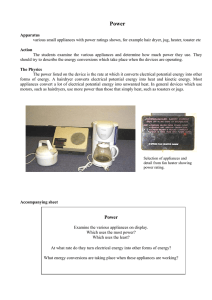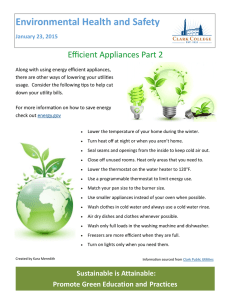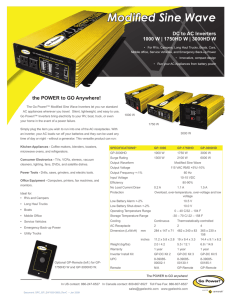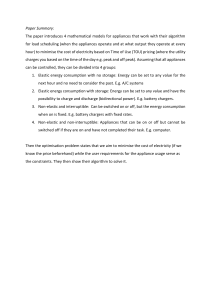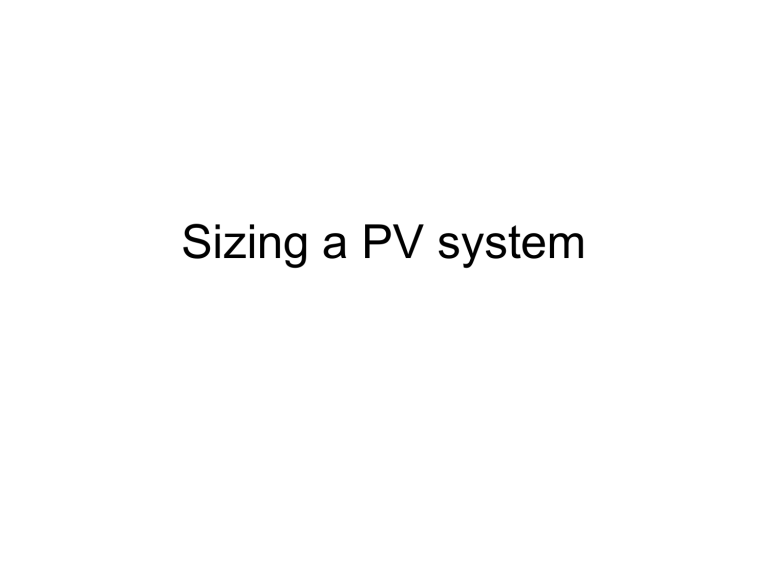
Sizing a PV system Content Systems Importance Steps Load evaluation Energy use profile of individual appliances Refrigerator Energy Consumption Profile demand response (DR). They are very good candidates to enhance them with “smartness”. The intermittent peak electricity use can be shifted in time, in order to reduce the overall peak energy demand on the grid. From the household perspective, time-of-use pricing will enable significant energy bill savings. However, the DR algorithms have to be implemented without incurring unacceptable consequences for the consumers. The main benefits of utilities that arise from using DR include: > automatic energy reduction without any inconvenience to consumers; > precise control of appliance power usage on a network level – a powerful facility for sharing the load among participating consumers; > a clear, real-time view of the aggregated demand-side energy-saving potential on the network that enables: > the prediction of required supply; > the setting of time-of-use and dynamic energy pricing; > the ability to minimize the need for purchasing spinning reserve, thereby lowering costs and significantly reducing carbon emissions problems related to loads For all systems (AC and DC supply systems): • A1 - Wrong selection: some loads are non-adapted for stand-alone PV systems. • A2 - wiring: substandard or inadequate wiring and protection devices will also cause poor system response. • A3 – Low efficiency: low electrical efficiency loads lead to over energy consumption. • A4 - Stand-by loads: stand-by mode of some loads waste energy. • A5 - Start-up: current spikes during the start-up of some loads can create temporal overload of the system. problems related to loads: Only for AC • AC1 - Reactive power: when appliances with capacitive or inductive loads are used, real circulating current differs from the consumed. • AC2 - Harmonic distortion: some electronic appliances with non-linear loads can create waveform deformation of the inverter output signal. • AC3 - Mismatch between load and inverter size: Low overall efficiency can result from oversized inverters operating at low-power for long periods. A1 Wrong Selection. • For good energisation it is better not to use electricity for all types of load. • For example, generally it is not appropriate to use PV electricity to produce heat. Example • The energy needed to take a shower is about 1 kWh, this daily habit accounting 30 kWh/month, or 500 Wp of installed PV power* • Using thermal collectors to directly heat water is much more costeffective for this usage (about 10 times cheaper than PV) * Assuming a water temperature of 10 ºC, and raise it to 38 ºC; for heating 30 l of water to take a shower we need: 30 lwater * 4,18 kJ/(kg*ºC) * 1 kg/1lwater * (38-10)ºC water * 3600s = 1kWh. • Calculation of installed Wp: assuming a daily average irradiation of 4000 Wh/m2, and a performance of the system of 50%, the Wp needed are: 1 kWh/day/50% * 1kWp/4hp = 500Wp A2 - wiring • Wiring is an important issue to guarantee correct performance when using appliances. Having undersized or damaged distribution cables, can lead to the following problems: Problems: • If section of wires is undersized or selection of fuses is incorrect, high current through these can cause a fire ( by resistive heating). • Undervoltage may detrimentally affect the performance of some appliances. A3 Low efficiency • Generally speaking, inefficient appliances are cheaper to buy. Problems: If the system was sized for efficient loads and, inefficient devices are used, insufficient energy is available, resulting in: • Frequent cut-offs. • Frequent low SOC of batteries resulting in low life. • System undersized. • User unsatisfied and may even by-pass the controller. • If diesel genset runs periodically, operating costs can increase dramatically due to increase in demand/ or increased demand. saving energy with highefficiency appliances: A4 Stand-by loads Problems: • When these appliances are left on stand-by for hours or even days, their cumulative effect can become a significant part of system consumption. This may be reflected as low charge of the batteries and earlier cutoff of the system. • A recent study carried out in Japan estimated that about 10% of domestic electricity consumption is used to power appliances on stand-by. A5 Start-up • • • • • • • • • Some appliances consume high electric power (several times its rated power) at start-up. In case of AC current, the inverters should resist peaks of power several times higher than its rated power value, during the short start-up periods. The loads affected should have a starter, which could “soften” the start-up. The problem would be solved using loads according to the availability of power, always considering energy-availability (e.g. water pump with less kW but operating during longer time). In case of simultaneous start-up of the appliances, the peak power would be the sum of each one. Progressive start-up of the loads connected should be done, controlled by the inverter or another device. The last solution would be to use an alternative power source for problematic loads (e.g. a diesel generator,...). Specify the inverter continuous watts and surge watts by estimating the surge requirements correctly. Use a linear current booster or use permanent magnets in pumping systems to assist start-up. A starter used for a water pump could be a device, which produces a frequency variation of the output inverter AC signal, to improve the start-up of the water pump. start-up of a refrigerator start-up of a water pump AC1 Reactive power Problems: • The current to be delivered by the inverter is much higher than the real consumption, • resulting in a possible overcharging of the system. • Current through the cables is higher than necessary, resulting in the need to increase the wire section to reduce voltage drops. This will add to the cost of cabling. The consumption of an electric motor can have a phase between current and voltage of 50º (cos(50º)=0.64). The inverter has to supply, in this case, 1 / 0.64 of the current used by the load (1.56 x the motor current). AC1 Reactive power Solutions: • Reduce the need for inductive loads like conventional ballasts, etc. • Use of synchronous motors instead of induction motors in the relevant appliances. • Install capacitors at the inductive load or the distribution panel to provide the required amount of capacitive reactance. AC2 Harmonic distortion Problems: • This causes voltage deformation in the output signal of the inverter, which may occasion problems with the other loads. • Harmonics can shorten the life of the appliances by voltage stress and increased heating of electrical insulation. • Some devices need to sense ‘zero-crossings’ to control internal switching and could malfunction as the ‘zerocrossings’ may appear to shift because of harmonics. Solutions: • Use of output filtering or use of inverters with high switching frequency in situations where harmonics are expected. AC3 Mismatch between load and inverter size Problems: The energy consumed is higher than the expected one, resulting in: • Cutout of the system or permanent low SOC of batteries • High non-useful energy consumption. Solutions: • Use of a specific dedicated inverter for the application, or a modular inverter with working points of good performance ranging from low to its maximum power. Smart Consumers A key feature of the Hybrid grid is demand response (DR). As defined by the Association of Home Appliances manufacturers (AHAM) in December 2009 in a smart grid white paper, DR refers to a set of scenarios whereby the consumer, utility can reduce energy consumption during peak usage or other critical energy use periods. It is critical to reduce peak demand to avoid the use of high-cost and high-emission power-generating resources or when the utility encounters some other issue on the electrical grid that requires the reduction of electricity demand, it can send a signal to the home so that the system will reduce its electrical load during this critical time periods. Smart appliances In the smart appliances concept, the appliances are no longer passive devices, but active participants in the electricity infrastructure contributing to energy reduction and optimization of the electrical grid for greater compatibility with its greenest energy-generation sources. On this line, by providing a variable load, smart appliances connected to the smart grid are ideal complements to renewable energy such as wind and solar power, which are inherently variable in supply. First, the focus is on residential consumers, where the development of DR is more straightforward. Developing the smart grid and linking it to smart appliances and others products having DR capabilities will reliably and predictably reduce appliance electricity consumption in real time Smart appliances The way consumers interact with the grid is essential. Consumers must be able to choose when and how they want their smart appliances to participate in the smart grid. The offer of financial incentive – through time-of-use pricing or other incentive plans – will be the single biggest driver for consumers to change their energy consumption habits. Therefore, the smart appliances concept provides benefits to both the consumers that obtain direct economic benefits, and the utility and society at large. The best candidates for smart home appliances are: clothes washer, refrigerator, clothes dryer, dishwasher, water heaters and heating, air conditioning, battery charger (for electric cares). In the next years the smart appliance market is expecting to record an important grow. Smart appliances, by integrating them in the “Whirlpool Smart Device Network (WSDN)”: Resource Evaluation Resource Evaluation Resource Evaluation Resource Evaluation Resource Evaluation Resource Evaluation Resource Evaluation Resource Evaluation Resource Evaluation Resource Evaluation PV Module selection [JRC] Connection Inverters [JRC] Inverters Inverters Inverters Losses in PV system Losses in PV system PV Yield Final Yield including losses Final Yield including losses Costs Project Example Project Example Project Example Project Example JRC Resource JRC Resource JRC PV Photon Database PV Photon Database Inverters Photon Database Module placement


